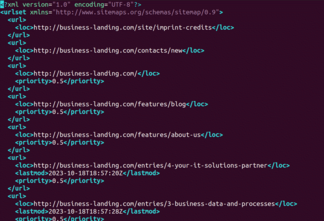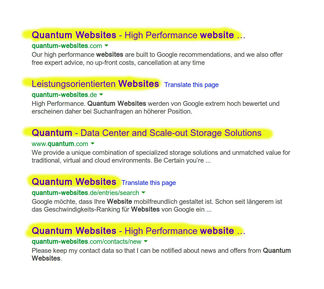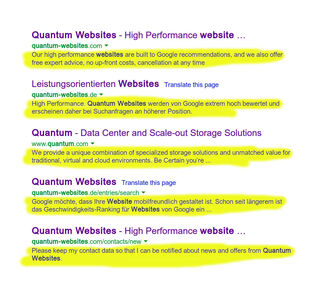Sitemap for improved SEO
What is a Sitemap?
There are two types of site map:
- XML- An XML Sitemap is in a format that is not normally viewed by regular website users. An XML Sitemap is created specifically for Search Engines to show details of the available pages in a website, their relative importance and frequency of content updates. The format of the sitemap is an open standard and detailed at sitemap.org
- HTML Sitemaps however are visible to a regular user to help navigate the website and has no impact to website ranking.
We will focus on XML Sitemaps for the rest of this article.
As soon as your website is in production ("live") a sitemap should be manually submitted to the search engines to trigger indexing. If not, it can take many months before your website is fully indexed. The search engines have no magic method to find your new website, so you must make sure that you tell them that you are online and have a new website..
If you use our services then our software generates a sitemap.xml for you. If you don't use our services then ask your website developer to show you how your sitemap.xml is generated. Prior to submission of your sitemap you need ensure that the data it contains is optimal for your SEO. It is important that the following values are set for all your important pages....
Title
You can individually set the title for each page of your website. This is important because search engines use this information to display and rank your website pages.
This important aspect of SEO is often ignored by website developers. By specifying the Title and Description for the important pages of your website your benefits are:
- Better search ranking
- Better targeting of your website to your intended audience
Your website software will usually generate titles automatically for each of your pages but we recommend that you review and determine whether more suitable titles are better than those provided by the your website software. If you use our software, then you can make the updates yourself (we can provide secure access) or alternatively send the titles to us and we will update them for you.
There are a couple of important considerations to keep in mind when adding your page titles:
- The title should not be too long. As can be seen in Fig 2 above, if you have more than 60 characters, including the space character, your title may be truncated by the search engine.
- Use the title to say what the page is about not who you are. If your company is called 'John's Pipe Supplies Limited', then a title describing your USP, for example 'Quality Pipes of all types delivered in 24 hours' is probably better than just your company name.
Description
This is a longer description of your website page. Most search engines do not put much weight on the description when matching to search queries. For example putting 'We have the best prices in London for eggs' in your page description will not cause a match for somebody searching for 'best prices eggs London'. However, your description may be displayed by the search engines in the results page as shown in Fig 3.
Thus it is useful to set a description, otherwise the search engines will simply select their "best guess" of your page description from the actual page text, which may not be the text that you would want your search hits to display.
The description should be no longer than 140 characters, Google will sometimes accept more characters but Bing will not.
Change frequency
The sitemap itself optionally allows you to indicate how often the page is changed. Accepted values are: always, hourly, daily, weekly, monthly, yearly and never. It may not be known in advance how often your content will change, in which case our software allows you give the special value 'unknown'.
Priority
The sitemap also allows you to give a priority for each page. Since search engines do not have unlimited time to investigate (crawl) all the pages on your website, you can use the priority to highlight pages that are more important and should be investigated (crawled) first. The highest priority our software accepts is a value of 10, and the lowest is a value of 1. You should not assign the value of 10 to every page as the priority is a relative value, so if all pages were assigned 10 the search engines assume they all have equal priority.
Last Update
The date the page was last updated is shown in the lastmod attribute of the sitemap. You do not need to set this yourself as our software will automatically calculate the time and date. However, you do need to consider that if this value is set, then you may need to re-build and re-submit the sitemap.xml should the page have changed, otherwise the lastmod value in the sitemap will not reflect the actual date of the last update to that page. Keeping track of such changes can be quite complex, thus we recommend that you re-submit a sitemap at least quarterly, or immediately if you have made important changes to your website.
NOINDEX
Not part of the sitemap itself, but still worth considering before sitemap submission, the 'NOINDEX' meta tag will tell search engines to not include this page in their index. This may be useful if you are working on a page for your website that is in some sort of draft status or not quite ready for public release.
Sitemap Submission to Google, Bing & Yahoo
At Business Landing we make the extra effort to submit your website because we are then able to track its progress and receive early warning of any issues.
Please be aware that even with manual submission, it may take around 4-6 weeks before your website is fully indexed by all the major search engines.
After your website has been indexed, we will provide feedback on how the search engines view your website. At that point you can review your website and make changes that will enable you to better target your audience and potential customers.


